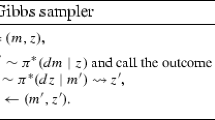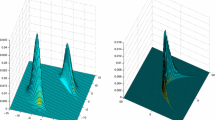Abstract
I present a new Markov chain sampling method appropriate for distributions with isolated modes. Like the recently developed method of ‘simulated tempering’, the ‘tempered transition’ method uses a series of distributions that interpolate between the distribution of interest and a distribution for which sampling is easier. The new method has the advantage that it does not require approximate values for the normalizing constants of these distributions, which are needed for simulated tempering, and can be tedious to estimate. Simulated tempering performs a random walk along the series of distributions used. In contrast, the tempered transitions of the new method move systematically from the desired distribution, to the easily-sampled distribution, and back to the desired distribution. This systematic movement avoids the inefficiency of a random walk, an advantage that is unfortunately cancelled by an increase in the number of interpolating distributions required. Because of this, the sampling efficiency of the tempered transition method in simple problems is similar to that of simulated tempering. On more complex distributions, however, simulated tempering and tempered transitions may perform differently. Which is better depends on the ways in which the interpolating distributions are ‘deceptive’.
Similar content being viewed by others
References
Berg, B. A. and Celik, T. (1992) New approach to spin-glass simulations, Physical Review Letters, 69, 2292–5.
Besag, J., Green, P., Higdon, D., and Mengersen, K. (1995) Bayesian computation and stochastic systems (with discussion), Statistical Science, 10, 3–66.
Duane, S., Kennedy, A. D., Pendleton, B. J., and Roweth, D. (1987) Hybrid Monte Carlo, Physics Letters B, 195, 216–22.
Geyer, C. J. (1991) Markov chain Monte Carlo maximum likelihood, in E. M. Keramidas (ed), Computing Science and Statistics: Proceedings of the 23rd Symposium on the Interface, pp. 156–63, Interface Foundation.
Geyer, C. J. and Thompson, E. A. (1995) Annealing Markov chain Monte Carlo with applications to ancestral inference, Journal of the American Statistical Association, 90, 909–20.
Kennedy, A. D. (1990) The theory of hybrid stochastic algorithms, in P. H. Damgaard, et al. (eds) Probabilistic Methods in Quantum Field Theory and Quantum Gravity, New York: Plenum Press.
Kirkpatrick, S., Gelatt, C. D., and Vecchi, M. P. (1983) Optimization by simulated annealing, Science, 220, 671–80.
Marinari, E. and Parisi, G. (1992) Simulated tempering: A new Monte Carlo scheme, Europhysics Letters, 19, 451–8.
Neal, R. M. (1993) Probabilistic inference using Markov Chain Monte Carlo methods, Technical Report CRG-TR-93-1, Department of Computer Science, University of Toronto.
Smith, A. F. M. and Roberts, G. O. (1993) Bayesian computation via the Gibbs sampler and related Markov chain Monte Carlo methods (with discussion), Journal of the Royal Statistical Society B, 55, 3–23 (discussion, pp. 53–102).
Author information
Authors and Affiliations
Rights and permissions
About this article
Cite this article
Neal, R.M. Sampling from multimodal distributions using tempered transitions. Stat Comput 6, 353–366 (1996). https://doi.org/10.1007/BF00143556
Issue Date:
DOI: https://doi.org/10.1007/BF00143556




